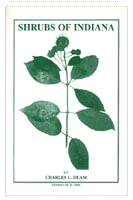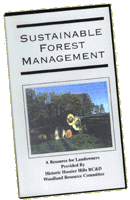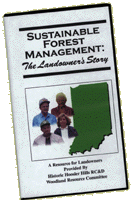
The Historic Hoosier Hills Woodland Resource Committee is an award-winning volunteer non-profit organization made up of landowners, professional foresters, and others interested in woodland conservation in southeastern Indiana. The goal of the Committee is to provide leadership for enhancement of economic opportunities within HHH's counties through conservation, improvement, and wise use and development of the area's woodland resources. Membership is open to anyone who shows interest.
A well managed woodland forest can provide periodic income from selective harvests while continuing to provide natural beauty, recreational opportunities, and diverse habitat of wildlife.
Indiana's climate and soils are excellent for growing some of the highest quality hardwood trees in the world.
 Woodland Committee activities include several forestry field days each year, an annual Outstanding Woodland Owner Contest, an annual Timber Industry Meeting for loggers and mill owners, and winter forestry-related workshops in cooperation with the Purdue School of Forestry and Natural Resources. We are also a member of the Regional Wood in Transportation Partnership - a five-state coalition of RC&D's and the U.S. Forest Service - whose purpose is to promote the use of native timber for producing vehicle and pedestrian bridges. The bridge pictured here is in Historic Hoosier Hills and is made of Pin Oak - a local Red Oak species. Click on the photo for a link to the Wood in Transportation Partnership Home Page at Morgantown, West Virginia.
Woodland Committee activities include several forestry field days each year, an annual Outstanding Woodland Owner Contest, an annual Timber Industry Meeting for loggers and mill owners, and winter forestry-related workshops in cooperation with the Purdue School of Forestry and Natural Resources. We are also a member of the Regional Wood in Transportation Partnership - a five-state coalition of RC&D's and the U.S. Forest Service - whose purpose is to promote the use of native timber for producing vehicle and pedestrian bridges. The bridge pictured here is in Historic Hoosier Hills and is made of Pin Oak - a local Red Oak species. Click on the photo for a link to the Wood in Transportation Partnership Home Page at Morgantown, West Virginia.
| Books |
The Commitee has reprinted two extensive field identification guides.
Both of these 330+ page books are available from the
Historic Hoosier Hills office at $16 each plus $3 shipping (USA only).
 |
Charles Deam's "Trees of Indiana" |
 |
| Charles Deam's "Shrubs of Indiana" |
| Videos |
The Committee has also produced two high-quality 25-minute videos.
They can be ordered from the
Historic Hoosier Hills office at $10.50 plus shipping (USA only).
 |
"Sustainable Forest Management" covers the value and need for multiple use management of our woodland resources by private woodland owners with the assistance of professional foresters. |  |
| "The Landowners Story" includes interviews with four area woodland owners on the importance of proper woodland harvesting and working with professional foresters. |
- "Alternative Income Opportunities" Conference
This conference was offered in October, 2000 with about 100 woodland owners in attendance. The focus was opportunities to produce income in addition to timber -- enterprises such as shiitake mushrooms, medicinal herbs, maple syrup, wood for crafts products, etc. Breakout sessions also include financial and estate planning for woodland owners; recreational and sport uses of woods, etc. Partners included Purdue University Cooperative Extension Service and School of Forestry and Natural Resources; Ohio State University Cooperative Extension Service and School of Natural Resources; University of Kentucky Cooperative Extension Service and Department of Forestry; the Indiana Department of Natural Resources, Division of Forestry; and Historic Hoosier Hills.
- Economics of Forest Management Study
This study will provide long-term management information and income/expense records for several managed private woodlands in southeastern Indiana, and will demonstrate with figures that long-term hardwood management on suitable soil pays economically. While our state and private foresters know this from years of experience, Indiana has never done this kind of long-term study to provide hard data to back up the experience. The Purdue Extension Forester for southeastern Indiana has identified numerous woodland tracts that have management and financial records going back several decades. The Woodland Committee will help secure funding to pay for the study and for publication of the results.
- Jefferson Proving Ground Woods Project
The Jefferson Proving Ground is a 55,000 U.S. Army munitions testing facility in southeastern Indiana which closed in 1995 after a 55-year history (see Jefferson Proving Ground Heritage Partnership). The north 50,000 acres is too heavily contaminated with unexploded ordnance to clean up and reuse. It was converted to the "Big Oaks National Wildlife Refuge" with limited public access under the direction of U.S. Fish and Wildlife Service.
The south 5,000 acres has been sold under contract to a local businessman with the exception of a few small tracts which were offered to local units of government for public uses (parks). One tract is a 323-acre wetland woods on the far west side of the south end, which is predominantly Pin oak and has been untouched for over 50 years. The Board of Commissioners of Jefferson County is negotiating with the Department of Defense to secure that 323-acre woods. They plan to contract with Historic Hoosier Hills to manage it as a woodland demonstration site (through our Woodland Committee) and an outdoor classroom (through our Conversation Education Committee).
- Verastau Forestry Field Day
Verastau was the home of U.S. Senator William Holman in the late 1800's and early 1900's. Verastau is located on a bluff overlooking the Ohio River and the City of Aurora, and includes over 150 acres from the original farm of over 400 acres. Senator Holman was the author of the enabling legislation that created the U.S. Forest System. Verastau has had over 100,000 trees planted on it, mostly in the 1930's. The property is currently owned by the Cornelius O'Brien Foundation and is managed by Historic Landmarks Foundation of Indiana.
Historic Landmarks, Historic Hoosier Hills, and our Woodland Committee partnered to plan and offer a forestry field day in May of 2000. This partnership married the historic preservation and urban forestry aspects of Verastau with the forest management aspects. They plan to hold another field day in May of 2001 and will dedicate a plaque honoring Senator Holman at that field day.
Our Valuable Forest Resource
Some of the Benefits of Trees
| Trees are a renewable resource, providing us with everything from wood construction materials to toothpicks, paper products, pharmaceuticals, adhesives, and dozens of chemical products. | |||
| Trees can easily increase the value of residential real estate by 10% - 15%. | |||
| A healthy growing forest, while growing each pound of wood, will remove from the atmosphere 1-1/2 pounds of carbon dioxide and release back to the atmosphere one pound of oxygen. | |||
| One mature tree, in one growing season, provides enough oxygen (450 pounds) to keep one man breathing for one year. Fifty such trees are needed to supply the oxygen and "neutralize" exhaust of one automobile. | |||
| On a good summer "growing" day with 80 degree temperatures, one large maple tree may transpire as much as 150 gallons of pure, unpolluted water. | |||
| Shade trees are "air conditioners" that make no demand on your electric power and can cool your home as much as 12 degrees. | |||
| Well designed tree windbreaks can save 10-20% on winter home heating energy. | |||
| Trees help provide for America's economic growth and stability. | |||
| Indiana's Forest Products Industry is the sixth largest manufacturing industry in the state, employing over 50,000 Hoosiers. |
[HHH Council Board of Directors] [Committees and Projects] [Golden Triangle Counties] [Links to other RC&D's]
[HHH Additional Information] [Calendar of Events] [Information Request] [Monthly Newsletter]
site designed by: DETAILS MATTER